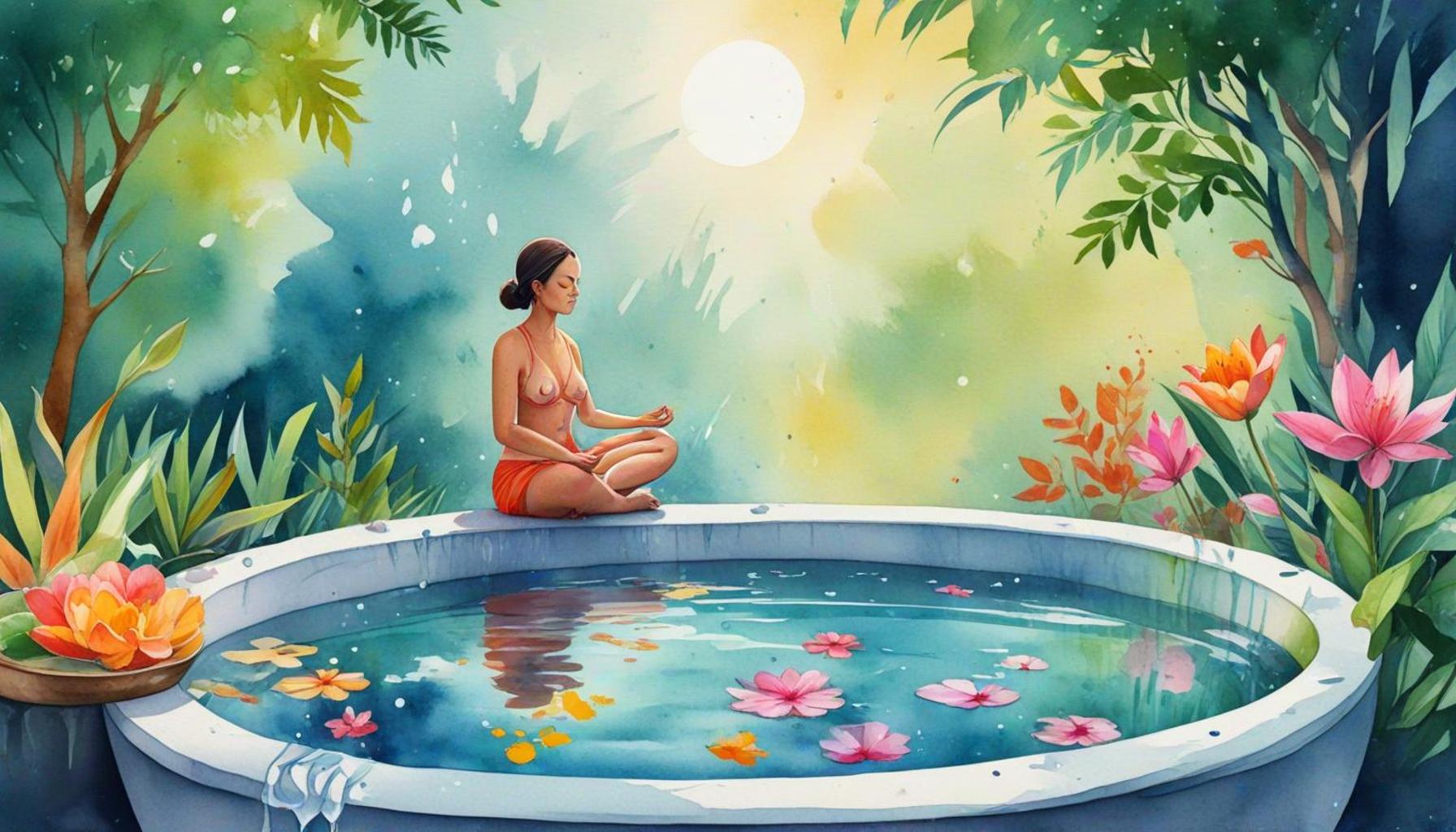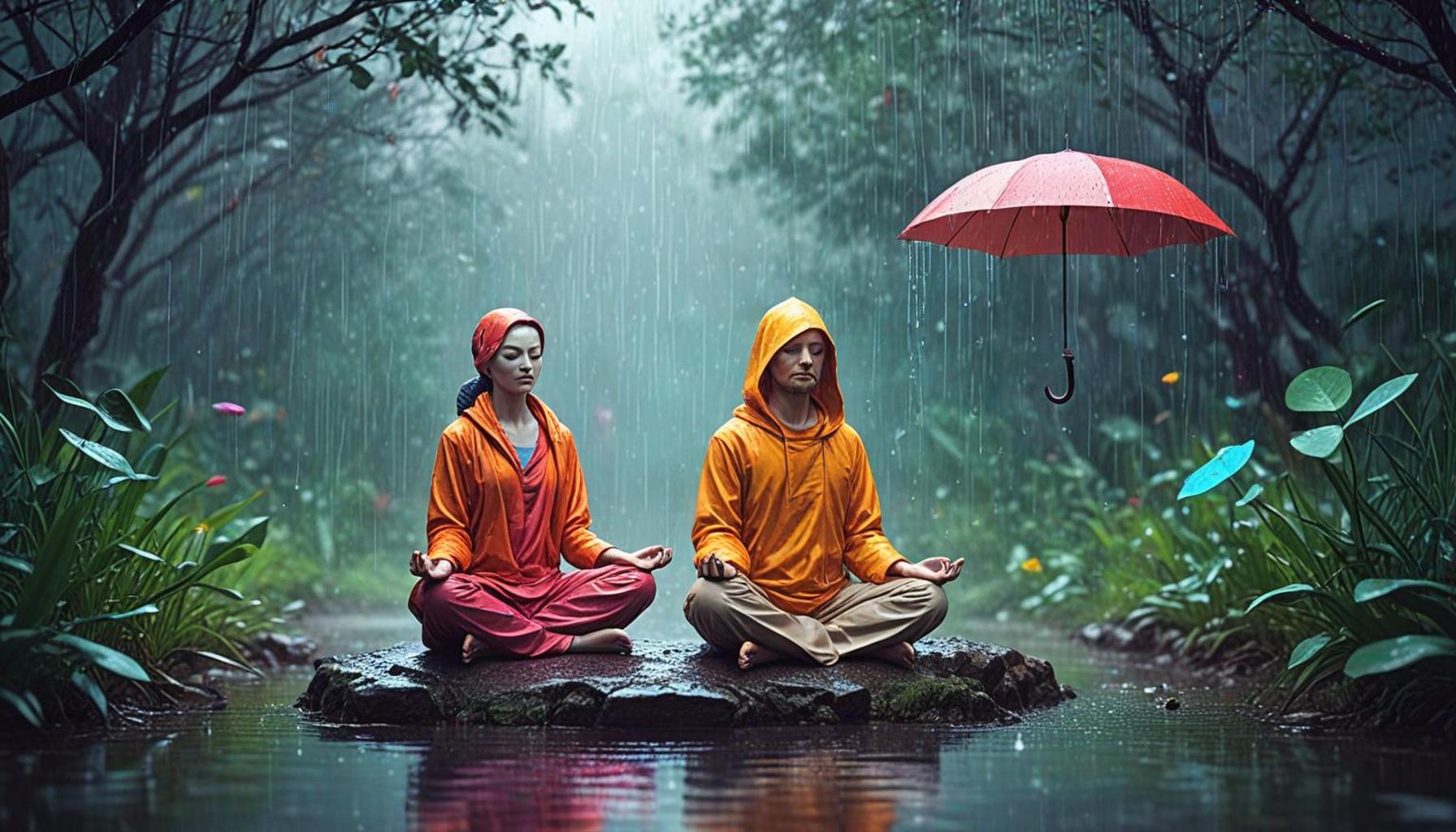The Influence of Colors and Lighting in the Bathing Environment to Improve Concentration During Meditation

Creating the right ambiance is essential for a successful meditation practice. The elements of colors and lighting play a vital role in enhancing the overall experience. In settings like a bathroom, where relaxation is often sought, these factors can significantly impact concentration levels. Imagine stepping into a serene space where the hues of the walls and the quality of light invite you to unwind and delve into mindfulness. This atmosphere is crucial in fostering a meditative state.
Why Colors Matter
The psychology of color suggests that different hues can evoke various emotions and responses. In the context of meditation, consider these beneficial colors:
- Blue: Often associated with calmness and serenity, blue can help to lower blood pressure and reduce feelings of anxiety. Painting your meditation space in soft blue tones can create a tranquil environment, making it easier to let go of daily stressors.
- Green: Symbolizing nature and balance, the color green promotes feelings of renewal and growth. Incorporating plants or green décor can enhance this soothing effect, helping you feel more connected to the natural world during your practice.
- Yellow: Known to encourage positivity and energy, yellow can uplift your spirit and instill a sense of happiness. In moderation, yellow decorations or accents can brighten a space, making it inviting and energizing for your meditation sessions.
The Role of Lighting
The type of lighting can either facilitate or hinder your meditation journey. Here are some key lighting types to explore:
- Natural Light: Ideal for morning sessions, it helps to boost energy and creates an invigorating atmosphere. Positioning your meditation space near a window allows for the gentle diffusion of sunlight, which can make your practice feel more alive.
- Soft Lighting: This kind of lighting creates a tranquil atmosphere conducive to relaxation. Utilizing warm-toned lamps or dimmable lights can help establish a calming environment that encourages introspection and deeper meditation.
- Dim Lighting: For evening sessions, dim lighting enhances the feeling of seclusion and introspection. Using candles or low-wattage bulbs can transform your space into a serene sanctuary, allowing you to focus inwardly without distractions.
Understanding these elements can lead to more effective meditation practices, ultimately improving mental clarity and focus. For instance, in Nigeria, where everyday life can be bustling and hectic, creating a personal oasis with the right colors and lighting can serve as an effective counterbalance to stress. As we delve deeper into this topic, discover how your bathing environment can enhance your meditation experience. A mindful soaking session, combined with the considerations of color and lighting, can amplify relaxation, turning an ordinary bath into a transformative retreat.
YOU MAY ALSO LIKE: Read read another article
Creating a Harmonious Space
To truly benefit from meditation, one must cultivate a space that harmonizes the elements of colors and lighting. This is especially significant in a location like the bathroom, which can easily transform into a personal sanctuary for reflection and tranquility. By making thoughtful choices in these areas, individuals can enhance their ability to concentrate and foster deeper meditative states.
The Psychological Impact of Colors
The impact of colors on emotions and mental clarity cannot be overstated. Each color carries its unique energy and associations, creating an atmosphere that can either uplift or diminish one’s ability to meditate effectively. Below are some additional colors that resonate well within a bathing environment:
- Purple: Often linked to spirituality and intuition, purple can inspire deeper meditation. Introducing soft purple elements, such as towels or bath mats, can evoke a feeling of sacredness, inviting a profound connection to one’s thoughts and feelings.
- White: Representing purity and simplicity, white can create a clear and uncluttered mind. A predominantly white bathing space can help refine the focus during meditation, allowing no distractions to disrupt one’s inner peace.
- Earth Tones: Colors like beige, terracotta, and soft browns mimic natural landscapes and can instill a sense of grounding. Surrounding oneself with these hues can evoke comfort and stability, especially significant in regions like Nigeria where the rich earth signifies connectivity to the land.
The Significance of Lighting
The kind of light in your bathing environment plays a crucial role in setting the mood for meditation. It’s not merely about illumination but about how that light interacts with colors to create a cohesive atmosphere. Some effective lighting options include:
- Warm LED Lights: These simulate the natural warmth of the sun, promoting relaxation while maintaining visibility. This warm hue is ideal for early morning or evening meditations, allowing you to ease into a mindful state.
- Fairy Lights: Placing string lights around the bathroom can evoke a whimsical atmosphere, soothing the senses. This technique is gaining popularity among couples and families in urban Nigerian settings, creating a cozy vibes for meditation and relaxation.
- Light Filters: Utilizing sheer curtains or blinds can diffuse harsh sunlight, creating a soft, inviting space that is less distracting, perfect for individuals who find bright light overwhelming.
As we explore the integration of colors and lighting into the bathing environment, it becomes evident that mindful choices in these areas are key to improving concentration during meditation. The simple act of rearranging your space with intention can lead to enhanced mental clarity and a more fulfilling meditation experience. By recognizing the profound effect of these elements, practitioners in Nigeria can cultivate a meditative retreat that provides solace amidst the bustling pace of daily life.
| Color and Lighting Category | Impact on Meditation |
|---|---|
| Soft Blues | Promotes calmness and clarity, enhancing deep focus during meditation sessions. |
| Warm Yellows | Encourages positivity and energy, helping to uplift mood while maintaining concentration. |
| Natural Lighting | Enhances awareness and connection to nature, which is beneficial for mindful meditation practices. |
| Dim Lighting | Helps to minimize distractions, allowing for deeper introspection and enhanced meditation depth. |
Understanding the psychological effects of color and lighting can transform the bathing environment into a sanctuary for concentration and meditation. Research indicates that colors like soft blues create a serene atmosphere, making it easier for practitioners to enter a state of mindfulness. Likewise, incorporating warm yellows into the lighting setting introduces an uplifting aura, which supports sustained focus during sessions.Natural lighting, often praised for its ability to connect us with the world beyond, can enhance one’s awareness and aid in establishing a meditative state. It reflects the beneficial properties of sunlight that many cultures have revered throughout history. In contrast, using dim lighting can effectively reduce stimuli that compete for attention, promoting a more profound meditative experience.Incorporating an array of colors and varying light intensities might just be the key to elevating your meditation practice. Each element serves a unique purpose, providing a customizable approach tailored to individual needs. As you explore these sensory aspects, consider how an intentional environment can significantly enhance your meditative journey.
SEE ALSO: Click here to read another article
Enhancing Sensory Experiences
Beyond visual appeal, the sensory experience of a bathing environment goes hand in hand with colors and lighting. To cultivate a space that fosters concentration during meditation, practitioners should also consider how other senses interact with visual elements. Integrating scents and textures can amplify the effects of color and light, creating a holistic atmosphere conducive to mindful practices.
The Aroma Connection
Aromatic elements, interwoven with thoughtful color schemes and lighting, can create an immersive mindfulness experience. For instance, using essential oils in conjunction with calming colors such as soft blues or muted greens can deepen relaxation. Scents like lavender, known for its soothing properties, can complement a purple hue, enhancing spirituality and emotional clarity during meditation.
Additionally, integrating scents from local Nigerian botanicals, such as frankincense or myrrh, can evoke a natural connection to cultural heritage. Incorporating these scents through diffusers or candles allows for a sensory layer that resonates with the rich traditions of meditation and spirituality. The aromatic experience merges seamlessly with colors and lighting, offering steady waves of calm that can facilitate longer and more focused meditation sessions.
Textures That Soften the Space
The textures in your bathing area can be just as influential as colors and lighting. Soft fabrics like cotton, bamboo, or linen in calming colors can enhance comfort during meditation. When individuals surround themselves with tactile sensations that are gentle to touch, it can deepen their connection to themselves. For instance, a plush bathmat in a heavenly blue can ground an individual while adding a touch of serenity to the space.
In Nigerian homes, incorporating locally-made woven baskets or clay bowls can introduce natural textures that hint at cultural authenticity. Not only do these elements connect one to their roots, but they can also elevate the serenity of the bathing environment, thus supporting focused meditation practice.
The Influence of Natural Elements
Integrating elements of nature through colors, lighting, and organic materials can significantly enhance the bathing atmosphere’s meditative quality. Natural light is a powerful tool; it ebbs and flows throughout the day, offering different qualities that can be appreciated during meditation. Early mornings are impactful due to the gentle embrace of dawn light, which can wash over calming greens or soft beiges, creating an ethereal setting for examination of the inner self.
Moreover, introducing houseplants into this sacred space can harmonize colors and add a key aspect of tranquility. Plants like peace lilies or sansevierias not only purify the air but can also foster a sense of vibrancy and energy. Combined with warm lighting, the interplay of greens and soft yellows creates a nurturing space where concentration thrives.
These methods showcase the interplay between color, light, and senses in creating a bathing environment that enhances focus and tranquility during meditation. Recognizing the contributions of aromas, textures, and natural elements allows for a rich, immersive experience, ultimately fortifying a path towards deeper self-discovery and mindfulness. For individuals in Nigeria, adapting these strategies can make meditation more resonant and impactful, creating a personal space that speaks to both personal and cultural identities.
CHECK OUT: Click here to explore more
Conclusion: Cultivating Tranquility Through Design
In conclusion, the thoughtful integration of colors and lighting in the bathing environment significantly enhances concentration during meditation. By creating a harmonious interplay between visual elements and sensory experiences, individuals can establish a sanctuary that encourages mindfulness and personal growth. The calming presence of soft blues, muted greens, and warm lighting not only soothes the mind but also promotes a deeper connection to oneself.
Moreover, incorporating elements such as aromatic substances and inviting textures, especially those rooted in local culture, adds richness to the meditative practice. Utilizing fragrances, such as frankincense and lavender, alongside tactile materials like plush fabrics or woven crafts, builds an immersive atmosphere where mindfulness can thrive. The introduction of natural elements further strengthens this ambiance, with houseplants serving to purify the air while acting as reminders of our intrinsic bond with nature.
As more individuals in Nigeria and beyond explore these design principles, the act of meditation can transform into a more resonant and impactful journey. By recognizing the significant role that colors and lighting play in cultivating a focused and calming bathing environment, practitioners can tap into their personal and cultural identities, enhancing their path toward mindfulness. This intrapersonal exploration may ultimately unlock the potential for greater self-discovery and emotional clarity, paving the way for a more centered and peaceful existence.



